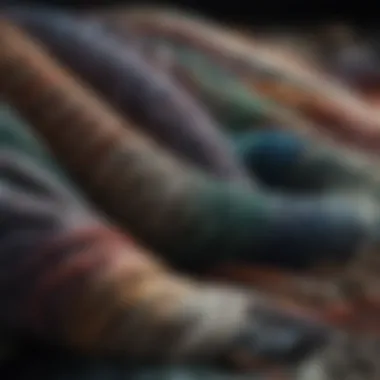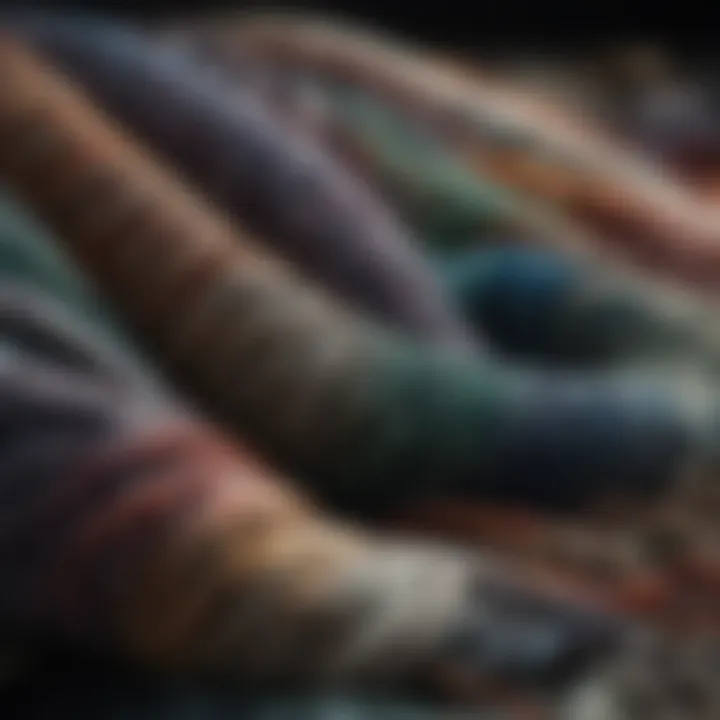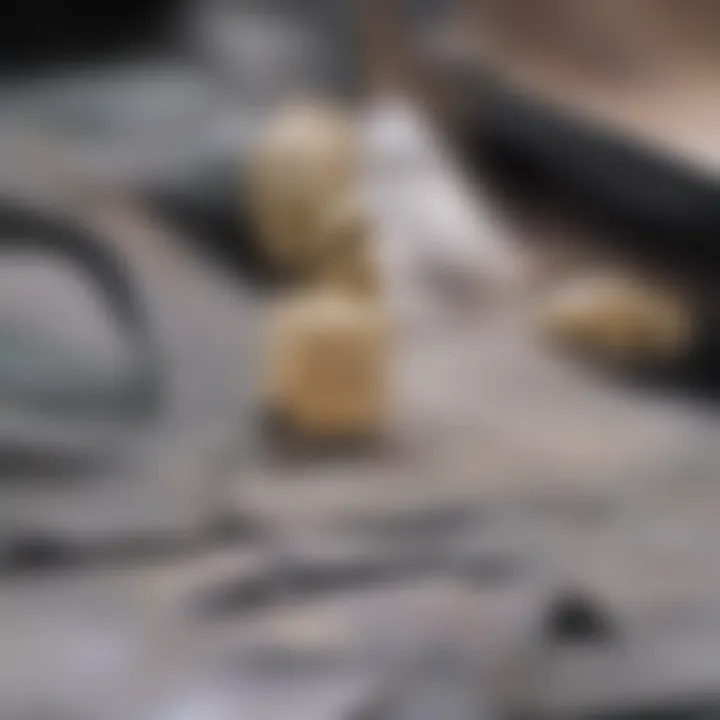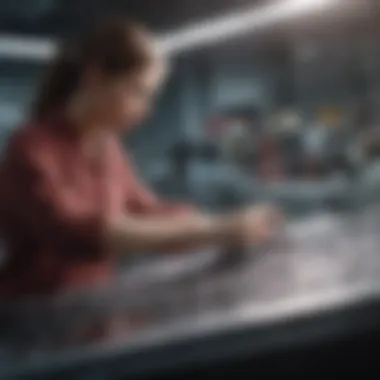Recycled Textile Products: Innovations and Impacts


Intro
The discussion around recycled textile products has gained significant traction in recent years. This shift is driven by heightened awareness of environmental issues caused by textile waste and the ongoing quest for sustainability in the textile industry. The increasing volume of discarded clothing and fabrics poses serious challenges. The traditional linear model of consumption—production, use, and disposal—has proven unsustainable. In response, the world is moving towards more circular practices that focus on recycling and reusing materials.
Recycled textile products embody this shift. They highlight innovative solutions that address waste reduction while meeting consumer demands for sustainability. The multidisciplinary nature of this subject encompasses environmental science, textile technology, and economics. Thus, it necessitates a comprehensive analysis to understand its complexities.
This exploration will cover recent technological advancements, the economic potential of recycled materials, and the perceptions surrounding these products. Special emphasis will be placed on the circular economy, consumer behavior, and regulatory frameworks shaping the industry.
Research Context
Background and Rationale
Textile waste is a growing global concern. According to estimates, billions of tons of textiles are discarded annually. The environmental implications are severe, contributing to landfill overflow and pollution. The deficiency in recycling rates exacerbates these problems. Transitioning to a circular economy can offer pathways to mitigate these environmental challenges.
Recycled textile products emerge from a need to capitalize on this potential. They reduce dependency on virgin materials and lessen environmental footprints. Thus, understanding their impact is crucial for sustainable development within the textile sector. Furthermore, as consumer preferences shift towards eco-friendly products, the market for recycled textiles grows. This evolution prompts businesses to innovate in production techniques and design.
Literature Review
The literature surrounding recycled textiles suggests a rapidly evolving field. Several studies focus on innovations in recycling technologies, such as chemical recycling processes and the use of biodegradable materials. Others emphasize consumer attitudes towards sustainable products. A notable point is how perception influences purchase behavior. Studies reveal that consumers increasingly prioritize sustainability, affecting market dynamics.
Furthermore, the economic implications of circular textile practices illustrate significant opportunities. Some research highlights case studies where companies have successfully integrated recycled textiles into their product lines, subsequently increasing both brand value and consumer loyalty. This synergy between environmental responsibility and economic viability reiterates the necessity of exploring recycled textile products.
Methodology
Research Design
This analysis employs a qualitative research design. It synthesizes findings from existing literature, highlighting key trends and challenges. Various sources were examined, including industry reports, academic papers, and market analyses. This approach allows for a well-rounded understanding of the multifaceted issues related to recycled textiles.
Data Collection Methods
Data was collected through the review of secondary resources. Sources include scholarly articles, industry reports, and relevant online platforms such as en.wikipedia.org and britannica.com. This method ensures a comprehensive overview of current knowledge and future directions.
> "A circular economy encourages the reuse of materials, fundamentally changing the textile industry's approach towards waste."
Preamble to Recycled Textile Products
Recycled textile products play a significant role in addressing the issues of sustainability within the fashion and textile industry. As global consumers become more aware of the environmental consequences of fast fashion, the focus shifts towards recycling initiatives. This introduction emphasizes the necessity of developing recycled textiles, considering both their potential benefits and the challenges they present. Over the next sections, we will explore the fundamentals and complexities that define this innovative field.
Defining Recycled Textiles
Recycled textiles refer to products manufactured from pre- or post-consumer waste. This waste includes discarded clothing, textile scraps, and other materials that would typically end up in landfills. The recycling process transforms these materials into usable fibers and fabrics, thus creating new products while minimizing waste.
There are two primary types of recycled textiles: mechanical and chemical. Mechanical recycling involves physically breaking down textiles into fibers. It often includes processes such as shredding and carding. On the other hand, chemical recycling entails using chemical processes to separate fibers from dyes, metals, or other materials. This method leads to a finer quality of recycled textiles, which can be essential for high-end applications.
The significance of defining recycled textiles extends beyond a simple classification. It lays the groundwork for understanding the recycling processes, the value chain, and the environmental impacts. Additionally, consumer awareness about recycled textiles can encourage more sustainable practices in the textile industry.
Brief History of Textile Recycling
The practice of textile recycling is not a recent phenomenon. Its roots can be traced back several centuries. Initially, textile recycling was primarily a practical necessity, as people made efforts to reuse materials during times of war or economic hardship. Fabrics were often rewoven or repurposed into new garments at home.
In the 20th century, the industrial revolution and the rise of fashion led to increased textile waste. However, during this time, the concept of recycling began to gain traction. The 1970s saw the first organized textile recycling initiatives. Many countries recognized the need to manage textile waste more sustainably, leading to the establishment of various recycling programs.
Currently, textile recycling is emerging as a vital strategy for reducing the environmental impact of the textile industry. Recent advancements in technology have further transformed textile recycling practices, allowing for more efficient and effective recoveries of valuable materials.
"The recycling textile industry is evolving rapidly, driven by technological innovations and increased demand for sustainable practices."
In summary, understanding the definition and history of recycled textiles is crucial to appreciating the current market dynamics and future trends. This background sets the stage for the in-depth analysis of innovations and impacts that will follow in this article.
The Importance of Recycling in Textiles
Recycling textiles is a pressing issue that carries significant weight in discussions about sustainability and environmental responsibility. The value of recycling in the textile sector extends beyond mere waste management; it encompasses a wide array of benefits that reach into environmental preservation, resource efficiency, and social responsibility. By grasping the importance of recycling textiles, one can appreciate its role in shaping a more sustainable future.
Environmental Impacts of Textile Waste
Every year, millions of tons of textile waste end up in landfills across the globe. The environmental consequences are profound. Textile products are typically made from synthetic fibers, which can take up to 200 years to decompose. This prolonged decomposition contributes to the buildup of harmful materials in the environment, including microplastics that seep into water systems. According to the Environmental Protection Agency, textiles are the second-largest category of waste in landfills, trailing only food waste.
Recycling textiles helps mitigate these adverse effects. When garments and fabrics are processed for recycling, it reduces the need for virgin materials like cotton, polyester, and other synthetic fibers. This reducing leads to lower water consumption and less land degradation. Furthermore, recycling textiles can help lower greenhouse gas emissions significantly. According to a study published by the Ellen MacArthur Foundation, if global recycling rates reach 20% in the textile industry, it could prevent 300 million tons of CO2 emissions annually.


"The circular economy and textile recycling represent a confluence of environmental care and economic opportunity."
In summary, minimizing textile waste through effective recycling practices is essential for reducing the environmental footprint of the textile industry.
Social Considerations and Ethical Implications
Beyond the environmental factors, the social implications of textile recycling are significant as well. Fast fashion and consumerism have fostered a culture of disposability, leading to poor labor practices in many developing countries. When consumers choose to support recycled textiles, they often contribute to an ethical supply chain that values sustainability and fair trade.
Recycling can offer job opportunities in areas such as sorting, processing, and resale of recycled fabrics. These jobs can be a source of livelihood for many, promoting economic stability within communities. Moreover, the promotion of recycled textile products can foster awareness of sustainable consumption among consumers, inspiring them to make choices that benefit both the planet and the people involved in the production process.
However, the issue of quality is imperative. Some recycled products may not meet consumer expectations, which can deter potential buyers. Education about the value of recycled textiles and their impact is crucial for bridging this gap.
Innovation in Recycled Textile Products
Innovation plays a critical role in the development of recycled textile products. The textile industry is notoriously resource-intensive. It grapples with significant waste and environmental issues, making innovation essential for sustainable practices. Embracing innovation enhances the efficiency of recycling, reduces waste, and offers new materials that contribute positively to the economy and sustainability goals.
As consumer awareness grows around environmental impacts, companies must adapt to market demands for eco-friendly options. New technologies are revolutionizing the recycling process, ensuring better quality and performance of recycled materials. This shift not only attracts discerning consumers but also positions businesses as responsible entities in a competitive marketplace.
Advancements in Recycling Technologies
Recent advancements in recycling technologies are transforming the landscape of textile reuse. Mechanical and chemical processes are key areas of focus. Mechanical recycling involves shredding, sieving, and carding, which allows for the recovery of fibers from post-consumer textiles. This method is effective for natural fibers like cotton but can be limiting for synthetic materials.
On the other hand, chemical recycling technologies, such as depolymerization, create opportunities for recycling polyester and nylon. These processes break down polymers into their basic building blocks. This method not only allows for a broader range of materials to be recycled but also contributes to the production of high-quality fibers that can compete with virgin materials. Some notable advancements include:
- Enzyme-based processes that ensure faster breakdown without using high temperatures.
- Solvent-based recycling, which offers higher purity for the final product.
- Closed-loop systems, which focus on reducing waste and ensuring materials stay within the production cycle.
"The focus on recycling technologies reflects a broader ambition to close the loop in textile production, combining sustainability with innovation."
Emerging Materials from Recycled Textiles
Emerging materials from recycled textiles represent a significant step towards a more sustainable textile industry. Post-consumer textiles no longer merely serve landfill purposes; they are now being transformed into useful resources. Innovators explore a variety of options, crafting new fabrics that have both aesthetic appeal and environmental responsibility.
Some notable materials created from recycled textiles include:
- Recycled polyester, made from plastic bottles, reducing ocean and landfill waste.
- Recycled cotton, which can be blended with virgin cotton to maintain quality while reducing resource consumption.
- Recycled nylon, particularly from discarded fishing nets, presents challenges but also impressive performance characteristics.
Companies are actively integrating these materials into their product lines. The benefits are manifold:
- Reducing dependence on virgin materials.
- Lowering carbon footprint associated with textile production.
- Boosting market demand for sustainable fashion choices.
Ultimately, the innovation in recycled textile products represents both a technological evolution and a fundamental shift in how society treats waste. Understanding these advancements allows for a more nuanced appreciation of how the textile industry can evolve against a backdrop of environmental stewardship.
Processes of Recycling Textile Products
Recycling textiles involves various methods that are essential to support sustainability efforts in the fashion and textile industry. Understanding these processes will help grasp the significance of recycled textile products. The methods considered in this section provide insight into how textiles can be transformed for re-use, ultimately aiming to reduce waste.
Mechanical Recycling Techniques
Mechanical recycling is the most common method used today. This process involves physically breaking down the textiles into smaller fibers. It is particularly effective for textile types such as cotton and polyester. Here’s how mechanical recycling generally happens:
- Collection and Sorting: Used textiles are collected and sorted based on fiber type, color, and quality.
- Shredding: The sorted textiles are then shredded into smaller pieces. This stage is critical as it prepares the fabric for further processing.
- Carding: After shredding, the fibers undergo carding, which aligns and separates them into thin sheets.
- Spinning: The aligned fibers are spun back into yarn, which can be woven or knitted into new textiles.
- Finishing: Finally, the new fabric undergoes finishing processes, making it ready for further use in the manufacturing of clothing.
Mechanical recycling is often praised for its relative simplicity and lower environmental impact compared to other processes. However, it can result in a decrease in fiber quality over repeated cycles. Continuous use can lead to shorter fibers, which can impact the quality of the final product. This makes it essential to balance the mechanical recycling process with the need for high-quality textile products.
Chemical Recycling Processes
Chemical recycling is a more advanced method aimed at addressing some of the limitations associated with mechanical recycling. It involves breaking down fibers at the molecular level, using chemical processes to convert used textiles into their original raw materials. Here are the fundamental steps:
- Depolymerization: This is the initial step where the textile polymers are broken into their fundamental monomers. For example, polyester can be broken down into ethylene glycol and terephthalic acid.
- Purification: Following depolymerization, the resulting monomers are purified to remove any impurities or additives that may have been present in the original textiles.
- Repolymerization: The purified monomers are then repolymerized to form new polyester fibers or other types of fibers.
- Textile Formation: Finally, these new fibers can be turned into yarn and subsequently into fabrics, completing the recycling loop.
Chemical recycling offers several advantages. It is able to recover raw materials to a higher quality compared to mechanical methods, providing a closer match to virgin materials. This allows brands to create products with consistent quality. However, this process can be costly and requires careful management of chemicals involved. It also raises questions about environmental implications, particularly regarding the by-products generated during chemical processes.
"Effective recycling processes are crucial to the success of a sustainable textile economy. By understanding mechanical and chemical recycling, stakeholders can better implement strategies to minimize textile waste."
As the textile industry moves towards a more sustainable future, both mechanical and chemical recycling processes will need to evolve. Both have their strengths and weaknesses. Understanding the nuances of these methods is vital for anyone involved in the textile sector, as it will guide decision-making in developing effective recycling strategies.
Market Dynamics of Recycled Textiles


The market for recycled textiles is increasingly relevant due to the growing awareness regarding sustainability and environmental issues. As the textile industry is one of the largest contributors to pollution, understanding market dynamics becomes crucial for stakeholders, including manufacturers, consumers, and policymakers. This section explores the motivations driving consumer behavior toward recycled textiles and the broader economic implications, including challenges such as supply chain complexities.
Consumer Attitudes Towards Recycled Products
Consumer perception plays a pivotal role in the market dynamics of recycled textiles. Recent studies show that there is rising interest in sustainability, but this does not always translate into purchasing behavior. While many consumers express support for eco-friendly products, their willingness to pay a premium for recycled textiles varies.
Factors influencing these attitudes include:
- Awareness of environmental impact
- Quality and style perception of recycled products
- Marketing and brand positioning
Most consumers view recycled textiles as a favorable option primarily due to their positive ecological footprint. Many people associate recycled products with quality and uniqueness, particularly in fashion industries. Yet, some remain skeptical about the durability and aesthetic appeal of these items.
"A shift in consumer preferences towards sustainable goods is a key driver for changes in production strategies in the textile industry."
To change perceptions, brands need to increase awareness about the benefits of recycled textiles. Clear communication about the production process can help. Presenting case studies that show real-world implications can also shift attitudes positively.
Economic Opportunities and Challenges
The market for recycled textiles is not just an avenue for environmental responsibility but also a source of economic opportunity. Advances in recycling technology can lower production costs and foster new business models.
There are notable economic advantages:
- Cost Reduction: Companies leveraging recycled materials can reduce raw material costs over time.
- Market Expansion: Growing consumer demand for sustainable products creates opportunities for brands to diversify their offerings.
- Innovation Incentives: Businesses able to create innovative recycled products often capture more market share.
However, there are challenges that present barriers to the successful growth of this market. Key challenges include:
- Quality Assurance: Maintaining quality in recycled products can be an issue, as inconsistencies in raw recycled materials may affect final products.
- Supply Chain Complications: Sourcing sufficient volumes of recyclable textiles is often problematic. The current infrastructure for collecting and sorting textiles remains fragmented globally.
Thus, by addressing these challenges thoughtfully, companies can not only improve the viability of their products but also contribute to the larger goal of sustainability in textile manufacturing.
Regulatory and Policy Frameworks
The regulatory and policy frameworks surrounding recycled textile products are crucial in shaping the landscape of the industry. They create guidelines and standards that dictate how textiles are recycled, what materials can be used, and how manufacturers can advertise their recycled products. As consumers become increasingly concerned about environmental issues, strict regulations ensure that companies are held accountable for their waste management practices. These frameworks also help standardize processes, making recycling more efficient and effective across the sector.
Global Standards for Textile Recycling
Global standards for textile recycling are essential for promoting a minimum level of quality and environmental responsibility. Organizations such as the Global Recycling Standard (GRS) and the Recycled Claim Standard (RCS) provide benchmarks for companies. These standards help maintain the integrity of recycled materials, ensuring they meet certain quality and safety criteria. Without these guidelines, there is a risk of greenwashing, where companies could falsely claim their products are environmentally friendly.
Implementing global standards also eases international trade of recycled textiles, as companies can align their practices with the standards of other countries. This cross-border alignment fosters collaboration and reduces the fragmentation of recycling practices, encouraging innovation and investment in technology.
"Standards in recycling do not just enhance credibility, they also drive consumer trust in recycled textile products."
Government Initiatives and Support Programs
Governments worldwide recognize the significance of recycled textiles and have initiated various programs to promote sustainability in the textile sector. These initiatives range from funding research and development to implementing tax incentives for companies that engage in or promote recycling. For instance, the European Union has introduced several directives aimed at reducing textile waste and encouraging recycling.
Support programs often include public-private partnerships designed to boost innovation within the industry. By collaborating with academic institutions, these programs can develop new recycling technologies and methods that can be adopted widely.
Moreover, educational campaigns funded by governments can inform consumers about the benefits of recycled textiles and encourage them to choose these products. Enhancing consumer knowledge is a vital step towards increasing demand for recycled materials, thus making the recycling system more sustainable.
In summary, the regulatory and policy frameworks affecting the recycled textile industry are pivotal in establishing standards and encouraging initiatives that can lead to a more sustainable future. These frameworks not only guide companies but also play an essential role in consumer education and in promoting technological advancements.
Circular Economy in the Textile Industry
The concept of a circular economy has become increasingly relevant in the context of the textile industry. It addresses the flaws inherent in the traditional linear economy that often results in significant waste and resource depletion. In a circular economy, the focus shifts toward the continual use and regeneration of resources. This is pivotal for sustainable development in textiles as it creates a system that reduces environmental impact and generates economic benefits.
Concept and Benefits of Circularity
Circularity in textiles emphasizes minimizing waste through recycling and reusing materials. The core idea is to keep textiles in use, thereby extending their lifecycle. The benefits of circularity are multifold:
- Reducing Environmental Impact: By promoting recycling, the demand for virgin materials decreases, leading to fewer natural resources being extracted.
- Lowering Carbon Footprint: Circular practices can significantly cut greenhouse gas emissions associated with production and disposal.
- Economic Opportunities: A shift to circular business models can create new jobs in areas such as recycling, refurbishing, and resale.
This model also encourages innovation in product design, where textiles are created with the end of their lifecycle in mind. This proactive approach can lead to fabrics that are easier to recycle and less harmful to the environment.
Case Studies of Successful Circular Practices
Several companies have begun implementing circular practices effectively, serving as noteworthy examples:


- Patagonia: This outdoor clothing brand has been at the forefront of promoting recycling in textiles. Their Worn Wear program encourages customers to trade in used items for repairs or resell.
- H&M: The global retailer has initiated a garment collecting program that allows customers to bring in old clothes for recycling, aiming to close the loop on textile waste.
- Eileen Fisher: This brand invests in a take-back program, allowing customers to return used garments for renewal, exemplifying a sustainable cycle from production to repurposing.
These case studies illustrate the practical application of circular economy concepts in the textile industry. They highlight how brands can transform their operations to reduce waste while fostering consumer engagement. This shift not only addresses environmental concerns but also creates a competitive advantage by aligning with growing consumer preferences for sustainable products.
"The future of textiles lies in adopting circular principles, ensuring that resources are not merely discarded but continuously reused to benefit the economy and the environment."
Future Trends in Recycled Textiles
The exploration of future trends in recycled textiles is essential to understanding how the industry can adapt and thrive in an environmentally conscious market. This section will consider advancements in technology, shifts in consumer behavior, and the overall impact of these trends on the textile sector. As more brands look for sustainable solutions, the focus on recycled textiles is likely to grow. This evolution is vital not just for the industry’s survival but also for its potential to significantly reduce the environmental footprint of textile production and consumption.
Forecasting Technological Progress
As technology advances, the methods employed in recycling textiles continue to evolve rapidly. Innovations like automation in sorting and processing have begun to gain traction. Automated systems can efficiently identify and separate various fibers, enhancing material recovery rates. Technologies such as digital printing and 3D knitting are changing the landscape as well. They may lead to a reduction in waste during production.
Nanotechnology is another area with future potential. It could revolutionize material properties, allowing recycled textiles to have performance characteristics comparable to virgin fibers. For instance, fabrics could gain enhanced durability and resistance to wear and tear, making them more appealing to consumers. If recycled products can match or exceed the quality of newly produced textiles, market acceptance may drastically increase.
Additionally, blockchain technology may play a crucial role in transparency within the supply chain. This can boost consumer trust in recycled products, allowing customers to track the journey of the materials from waste to finished product. Increased transparency could also encourage manufacturers to adopt more sustainable practices by showing the economic and ecological benefits of responsible sourcing.
Potential Shifts in Consumer Behavior
Consumer attitudes towards sustainability are shifting markedly. As awareness of environmental issues rises, more individuals are prioritizing ethically produced goods. This trend is indicative of a broader societal change, where sustainability is becoming a key factor in purchasing decisions. In the realm of recycled textiles, this shift holds significant implications. Consumers are inclined to expect and demand greater transparency about the materials used in their clothing. They want assurance that their choices are making a positive impact on the environment.
The younger generation, particularly millennials and Gen Z, actively seeks sustainable options. Brands that communicate their recycled textile product lines effectively can cater to this market. They are looking for brands that resonate with their values and demonstrate genuine commitment to sustainability. Some industry leaders are recognizing the importance of marketing the unique stories behind recycled textiles. This storytelling can create an emotional connection that may influence purchasing behavior.
Moreover, the rise of social media has amplified the conversation surrounding sustainability. Platforms such as Facebook and Reddit serve as spaces for consumers to share experiences and opinions, further influencing market trends. The interconnectedness of the global community means that news about ethical practices can spread quickly, prompting brands to adjust their strategies accordingly.
In summary, the trends shaping the future of recycled textiles hinge on technological advancements and changing consumer preferences. The importance of adapting to these changes cannot be overstated.
"Technological progress and consumer behavior are interlinked. Understanding this correlation is crucial for the advancement of the recycled textile industry."
By embracing innovation and aligning with consumer values, the textile industry stands to gain significantly in the coming years.
Challenges Facing the Recycled Textile Industry
The challenges facing the recycled textile industry are crucial to understand, especially as the demand for sustainable practices increases. These challenges impact everything from production methods to market acceptance. Recognizing these hurdles allows stakeholders to devise effective strategies for improvement.
Quality and Performance Issues
Quality and performance hold significant weight in the recycled textile sector. Consumers often perceive recycled products as inferior. This notion is a major obstacle when it comes to wider acceptance. Many recycled textiles do not meet the same durability and aesthetic standards as virgin materials. Different factors influence the quality of recycled textiles:
- Raw Material Variability: The quality of the input materials can vary greatly. This inconsistency affects the final product's performance.
- Technology Limitations: Current recycling technologies might not be sophisticated enough to restore materials to their original state. This can lead to products that do not hold up well over time.
- Consumer Expectations: Shoppers often equate sustainability with lower quality, which can deter them from choosing recycled options.
To address these quality issues, companies must invest in advanced recycling technologies and develop better processing methods. Moreover, educating consumers about the benefits and capabilities of recycled textiles is necessary to reshape perceptions.
Supply Chain Complications
Supply chain complications pose another significant challenge in the recycled textile industry. Efficient supply chain management is essential for the smooth operation of recycling processes, and any disruption can have far-reaching effects. Several complications arise:
- Logistical Issues: Collecting sufficient quantities of used textiles for recycling can be difficult. This is compounded by a lack of infrastructure in many regions for textile collection and sorting.
- Supply Chain Transparency: There is often insufficient information about the origins of recycled materials. This lack of transparency can lead to trust issues among consumers and brands.
- Market Fluctuations: Changes in demand for virgin versus recycled materials can affect pricing and availability. Companies may find themselves either with excess recycled materials or insufficient quantities needed to meet demand.
Addressing supply chain issues requires collaboration among manufacturers, retailers, and recycling facilities. Developing robust processes to streamline operations will enhance efficiency. Creating a transparent system can also improve accountability and consumer confidence.
"The future of textile recycling relies on how effectively the industry addresses these challenges. Innovations in technology and strategic collaborations are essential for progress."
Understanding these challenges is critical for the growth and sustainability of the recycled textile industry. By tackling quality and performance issues as well as supply chain complications, the industry can pave the way for a more sustainable future.
Epilogue
The conclusion serves as a crucial element in our exploration of recycled textile products. It synthesizes the information presented, allowing for a comprehensive understanding of the innovations, impacts, and future directions in this field. This section not only recaps the key insights but also emphasizes the importance of sustainable practices within the textile industry.
Summary of Key Insights
In considering the various aspects of recycled textiles, several key insights emerge:
- Environmental Importance: The impact of textile waste on the planet is significant. Recycling reduces landfill contributions and lessens harmful emissions.
- Technological Advancements: Innovations in recycling technologies have led to more efficient processes, improving the quality of recycled materials and expanding their applications.
- Economic Viability: The market for recycled textiles is evolving. As consumer awareness grows, so does the demand, offering new economic opportunities for businesses in this sector.
- Regulatory Support: Governments are starting to implement policies that promote recycling, providing frameworks that encourage sustainable practices in the industry.
The Path Ahead for Recycled Textiles
Looking forward, the path for recycled textiles is paved with both challenges and opportunities. As the industry matures, several aspects will shape its future:
- Technological Innovations: Future advancements can further enhance recycling processes, making them more efficient and cost-effective. This may include better sorting technologies and novel chemical recycling methods.
- Behavioral Shifts: Consumer attitudes are expected to shift toward greater acceptance of recycled products. This could result from increased awareness of sustainability issues and the benefits of recycling.
- Circular Economy Practices: Embracing a circular economy will lead to more integrated approaches to production and consumption, reducing waste and maximizing resource use.
"The transition toward recycled textiles signifies a shift in how we perceive waste and resource management in the fashion industry."
As the textile industry continues to navigate the complexities of sustainability, the evolution of recycled textiles will play a pivotal role in addressing environmental challenges and redefining market dynamics.



